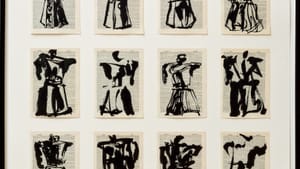Stay in the Loop
BSR publishes on a weekly schedule, with an email newsletter every Wednesday and Thursday morning. There’s no paywall, and subscribing is always free.
The pleasure of uncertainty
University of Pennsylvania's Arthur Ross Gallery presents 'William Kentridge: Universal Archive'

More than 75 linotype prints and 6 lectures delivered in 2012 are currently on view in William Kentridge: Universal Archive at the University of Pennsylvania's Arthur Ross Gallery. This is what happens when an artist has writer’s block.
When William Kentridge was awarded Harvard University’s prestigious Charles Eliot Norton Professorship in Poetry, he sat down to compose the lectures expected of recipients. While he waited for inspiration to strike, he made coffee, looked out the window, and did what comes naturally for a multimedia artist.
In, not of, apartheid
Born in Johannesburg, South Africa, in 1955, Kentridge grew up immersed in apartheid, though he belonged to neither the dominant white Christian minority nor the oppressed black majority. His parents, Lithuanian Jewish immigrants and attorneys, worked against repression, representing anti-apartheid figures such as Nelson Mandela. Those circumstances provided Kentridge a unique perspective on South Africa’s political system.
As a young man, he explored painting, acting, and filmmaking and says he failed at them all. In a 2014 Louisiana Channel video, William Kentridge: How We Make Sense of the World, he explained that his “only hope was the cross-fertilization between different mediums and genres.” Consequently, Kentridge probes the wounds inflicted by apartheid through drawing, sculpture, film, and theater, often in combination.
Though only one medium appears here, Universal Archive displays themes and iconography encountered across Kentridge’s oeuvre.
Gray possibility
Emerging from a world drawn in black and white, Kentridge’s art is infused with gray ambiguity. In 2014 he said, “There’s a desperation in all certainty. . . . Political uncertainty, philosophical uncertainty, uncertainty of images, is much closer to how the world is.”
His linotypes introduce additional uncertainty, given how they were made. Kentridge’s ink-on-paper images were carved on linoleum blocks by a master printer, who then inked and pressed them onto loose pages from the Shorter Oxford English Dictionary. Besides the intervention of another person, printing produces a reversed image, and inking and pressing are inexact processes, even under an artist’s scrutiny and at the hand of a master craftsperson.
Everything is unfolding
So, producing Twelve Coffee Pots (2012) was a tenuous undertaking, and though the coffee pot remains a coffee pot in the dozen images in this frame, across the gallery it becomes a woman. Elsewhere, Kentridge demonstrates how a bird perched on a branch can, in 12 steps, becomes a pacing man with a crest of hair and beaky nose.
The series are metaphors for Kentridge’s worldview that everything is in process, even if we prefer it to stay the same. Transformation comes mostly in subtle shifts, not sweeping changes.

Revolutions are rare, but art and knowledge, individuals and societies, are always evolving, bit by bit, for better or worse, until one day a majestic bird has become an unpleasant little autocrat. Refusing to acknowledge this does not keep it from happening.
Characteristic icons
Trees figure significantly in Kentridge’s work. Universal Archive has a forest of them, including the large companion works If You Have No Eye (2012) and Lekkerbeek Tree (2012). Lekkerbeek depicts a shattered kaleidoscope of a tree inscribed on carefully selected dictionary pages bearing a cicada, a steinbok, a soldier wearing a shako cap, and an array of hammers.
Nothing lines up. It's a misfit puzzle with arbitrary breaks, maybe signifying the colonial rule imposed on the South Africa of Kentridge’s youth. At the top of the tree, a few words sprout: “The Lie of the Land 2.”
The tree in If You Have No Eye is more graphically unified, but haunted. It’s studded with echoes of a country with a troubled past, such as, “The poor are salted meat,” “Remembering the treason trial,” “One should not be too hopeful of a ship sailing from Europe,” and “If you have no eye then use your heart.”
Charcoal imaginings
Kentridge is best known for 9 Drawings for Projection (1989–2003), a series of short animated films about the fictional Soho Eckstein, a mine owner and land developer in South Africa. An updated version, 10 Drawings for Projection (1989–2011) will be shown at Ross on September 27.
The artist builds his animation from charcoal sketches filmed in laborious stop-motion. A drawing is repeatedly altered through erasure, leaving shadows showing its evolutionary path. Besides producing a velvety, graceful moving image, the method provides an intimate view of Kentridge’s creative process, almost putting viewers into his head as thoughts flow onto the page.
For Kentridge, everything is unfolding. A drawing, an essay, what we know, what we believe, all are in flux, subjective, ephemeral, or, as he terms it, provisional. “You can see the world as a series of facts or photographs, or you can see it as a process of unfolding,” he said in 2014.
Kentridge clearly stands in the latter camp, accepting the uncertainty that comes with the creative process and really, with life itself. Whatever happens to the coffee pot happens, he seems to be saying, and we should all get comfortable with the uncertainty.
What, When, Where
William Kentridge: Universal Archive. Through November 11, 2018, at the University of Pennsylvania's Arthur Ross Gallery, 220 S. 34th Street, Philadelphia. (215) 898-2083 or arthurrossgallery.org.
Screening of 10 Drawings for Projection: September 27, 2018, at the gallery.
Sign up for our newsletter
All of the week's new articles, all in one place. Sign up for the free weekly BSR newsletters, and don't miss a conversation.
